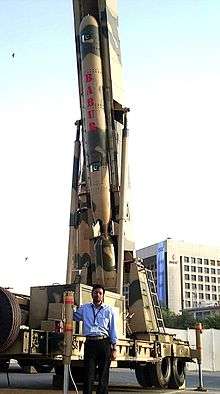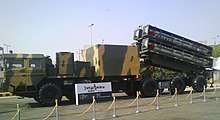Babur (cruise missile)
Babur (Urdu: بابر; named after the first Mughal Emperor Zahir-ud-Din Babur), also designated Hatf-VII, Translit: Target, is a short-range turbojet powered subsonic cruise missile that can be launched from land or underwater seaborne platforms. The missile was first tested in 2005 and is widely believed to have entered service with the Pakistan Army in 2010, and the Pakistan Navy in 2018.[4][5][6][7][8]
| Babur cruise missile; Hatf VII | |
|---|---|
 Babur cruise missile deployed at a show in 2006 | |
| Type | Medium-range subsonic cruise missile |
| Place of origin | |
| Service history | |
| In service | Babur I: 2010–present [1] |
| Used by | Babur–I/Babur–II Army Strategic Forces Command (ASFC) Babur–III Naval Strategic Forces Command (NSFC) |
| Production history | |
| Manufacturer | National Defence Complex (NDC) |
| Specifications | |
| Mass | 1,500 kg |
| Length | 6.2 m [1] |
| Diameter | 0.52 m |
| Warhead | 450 – 500 kg Conventional or nuclear |
| Engine | Turbofan (Solid-fuel rocket booster during launch) |
| Propellant | Solid fuel (booster rocket) Liquid fuel (jet engine) |
Operational range | Babur–I: 700 km[2] Babur–II: 750 km [3] Babur–III: 450 km |
| Maximum speed | 886 km/h (Mach 0.8) |
Guidance system | INS, TERCOM/DSMAC, GPS, GLONASS |
Launch platform | Transporter erector launcher (TEL) Underwater seaborne platform |
Origin


Pakistan claims to have developed the Babur in response to alleged reports that India was planning to acquire Patriot missiles from the US, in order to set up a ballistic missile defense system to counter Pakistan's arsenal of ballistic missiles.[9] Babur is the first cruise missile to be developed and designed by Pakistan.[7] Some analysts have pointed out similarities of the missile with Chinese and American designs, namely the DH-10 and Tomahawk.[10][11]
Design
The Babur's airframe is made up of a tubular fuselage, with a pair of folded wings attached to the middle section and the empennage at the rear along with the propulsion system. Propelled by a jet engine (either turbofan or turbojet), the Babur has a maximum speed of approximately 550 mph. Launched from ground-based mobile transporter erector launchers (TELs), the Babur can be armed with both conventional and nuclear warheads and has a reported range of 700 km (430 mi). On launch, a booster (rocketry) provides additional thrust to accelerate the missile away from the launch vehicle. After the launch the wings unfold, the booster rocket is jettisoned and the jet engine started. The missile is stated to have a high degree of maneuverability, allowing it to "hug" the terrain, and "near-stealth" capabilities.[6][12][13] Terrain-hugging ability helps the missile avoid enemy radar detection by utilizing "terrain masking", giving Babur the capability to penetrate enemy air defence systems undetected.[7][14]
The Babur's guidance system uses a combination of inertial navigation systems (INS), terrain contour matching (TERCOM) and GPS satellite guidance. The guidance system reportedly gives the missile pinpoint accuracy.[7] GPS access is not guaranteed under hostile conditions so the latest production models have also reportedly incorporated the Russian GLONASS. Future software and hardware updates could include the European Union's GALILEO and China's BeiDou Navigation Satellite System.[15] An upgraded variant tested on the 14 December 2016 included upgraded avionics where now the missile is able to accurately hit land and sea based targets without the aid of GPS. Also the missile is able to hit targets more accurately.[16][16][17][18]
Operational history
On August 12, 2005, Pakistan publicly announced that it had successfully test-fired a nuclear-capable cruise missile with a range of 500 km.[19][20] The missile was launched from a land-based transporter erector launcher (TEL).[9][21] Pakistan did not notify India of its test-firing as the existing notification agreement is limited to ballistic missile testing only.
On March 22, 2007, Pakistan test-fired an upgraded version of the Babur with an extended range of 700 km.[14]
On May 6, 2009, Pakistan conducted another test-firing but did not announce the event until 9 May 2009, citing political reasons.[22][23]
On October 28, 2011, Pakistan successfully test-fired its Babur cruise missile which has a range of 700 km. The ISPR said Babur was capable of carrying conventional and atomic warheads. A special feature of this launch was the validation of a new multi-tube missile launch vehicle (MLV) during the test. The three-tube MLV enhances manifold the targeting and deployment options in the conventional and nuclear modes. With its shoot-and-scoot capability, the MLV provides a major force multiplier effect for target employment and survivability.[24]
On June 6, 2012 Pakistan conducted a successful test-fire of the multi-tube, indigenously developed cruise missile Hatf-VII (Babur), which can carry both nuclear and conventional warheads with stealth capabilities. It was the third test-fire conducted by Pakistan in the recent past, of different capacity and load. “It can carry both nuclear and conventional warheads and has stealth capabilities”, said an official announcement of the ISPR. “It also incorporates the most modern cruise missile technology of Terrain Contour Matching (Tercom) and Digital Scene Matching and Area Co-relation (DSMAC), which enhances its precision and effectiveness manifolds.”[25] A new variant of the missile, termed Babur-1B, was test fired on 14 April 2018.[26]
Pakistan conducted a successful launch of an enhanced version of the Babur II missile On December 14, 2016. Enhancements include upgraded aerodynamics and avionics where now the missile is able to accurately hit targets without the aid of GPS, and also target sea-based targets as well land based targets.[16][17]
On 9 January 2017, Pakistan conducted a successful launch of the Babur III missile from an underwater mobile platform. The Babur-III has a range of 450 km and can be used as a second-strike capability.[27][28][29][30] It has been speculated that the missile is ultimately designed to be incorporated with the Agosta 90B class submarine which has been reported to have been modified.[31][32] On 29 March 2018, Pakistan reported that the missile had again been successfully tested.[33]
Variants
Harbah
Harbah is an anti-ship and land-attack cruise missile under development by Pakistan. ISPR, media wing of the Pakistan Armed Forces, reported that the missile was test fired on 3 January 2018 from the PNS Himmat, an Azmat-class fast attack craft. The missile is believed to have been derived from Babur cruise missile.[34][35][36]
See also
- Related developments
- Similar missiles
- Related lists
References
- "Hatf 7 "Babur" – Missile Threat".
- "Hatf 7 "Babur" – Missile Threat". CSIS.org. Retrieved 26 July 2017.
- "Pak missiles more superior than India's: Dr Samar".
- "Pakistan conducts successful test of Babur cruise missile". dawn.com. 2016-12-14. Retrieved 2017-12-28.
- "Hatf 7 "Babur" | Missile Threat". Missile Threat. Retrieved 2017-12-28.
- "Pakistan conducts successful test of Babur cruise missile". dawn.com. 14 December 2016. Retrieved 26 July 2017.
- Sharif, Arshad (12 August 2005). "Pakistan test-fires its first cruise missile". dawn.com. Retrieved 26 July 2017.
- "Pakistan Navy armed with latest Submarine and Babur Cruise Missiles". Pakistan Hotline. Retrieved 2017-12-28.
- "Information missing". Paktribune. Retrieved 8 October 2015.
- Kelleher, Catherine McArdle; Dombrowski, Peter (2015-09-23). Regional Missile Defense from a Global Perspective. Stanford University Press. p. 185. ISBN 978-0-8047-9656-9.
- Rajagopalan, Rajesh; Mishra, Atul (2015-08-12). Nuclear South Asia: Keywords and Concepts. Routledge. p. 114. ISBN 978-1-317-32475-1.
- "Pakistan Tests Nuclear-Capable Cruise Missile". Retrieved 8 October 2015.
- "Nuclear-capable Nirbhay cruise missile's test fails for the fourth time".
- "Pakistan test fires nuclear-capable missile". 26 July 2007. Retrieved 8 October 2015.
- "Hatf 7 "Babur"". Center for Strategic and International Studies. Archived from the original on 2016-10-27. Retrieved 2016-10-26.
- "Improved version of Babur cruise missile tested successfully". dawn.com. 15 December 2016. Retrieved 26 July 2017.
- "Pakistan successfully test-fires cruise missile 'Babur' with range of 700km". HindustanTimes.com. 14 December 2016.
- "Pakistan successfully tests fires indigenous Babur Cruise Missile – The Express Tribune". Tribune.com.pk. 14 December 2016. Retrieved 26 July 2017.
- "science14.htm". dawn.com. 20 August 2005. Retrieved 26 July 2017.
- Pakistan fires new cruise missile, BBC News, 11 August 2005
- "VOA News Report". VOANews.com. August 2005. Retrieved 26 July 2017.
- "Babar missile test-fired last Wednesday". The Nation. 9 May 2009. Archived from the original on 24 April 2013. Retrieved 8 October 2015.
- Schmitt, Eric; Sanger, David E. (29 August 2009). "U.S. Says Pakistan Made Changes to Missiles Sold for Defense". Retrieved 26 July 2017 – via NYTimes.com.
- "Pakistan successfully tests Babur Cruise missile". The News Tribe. 28 October 2011. Retrieved 8 October 2015.
- "N-capable Hatf-VII cruise missile test-fired". The News International, Pakistan. 6 June 2012. Retrieved 8 October 2015.
- "Pakistan test-fires enhanced version of Babur cruise missile | Jane's 360". www.janes.com. Retrieved 2018-04-25.
- "Pakistan fires 'first submarine-launched nuclear-capable missile'". 10 January 2017. Retrieved 26 July 2017 – via Reuters.
- "Pakistan test-fires first submarine cruise missile Babur-3". AryNews.tv. Retrieved 26 July 2017.
- "Pakistan 'launches first cruise missile from submarine'". 9 January 2017. Retrieved 26 July 2017 – via www.BBC.co.uk.
- "Pakistan fires 'first submarine-launched nuclear-capable missile' – The Express Tribune". Tribune.com.pk. 9 January 2017. Retrieved 26 July 2017.
- Panda, Ankit. "Pakistan Tests New Sub-Launched Nuclear-Capable Cruise Missile. What Now?". The Diplomat. Retrieved 2017-12-28.
- Panda, Ankit. "The Risks of Pakistan's Sea-Based Nuclear Weapons". The Diplomat. Retrieved 2017-12-28.
- "Pakistan tests its indigenously built Submarine Launched Cruise Missile Babur". The Financial Express. 2018-03-30. Retrieved 2018-03-30.
- Diplomat, Ankit Panda, The. "Pakistan Tests An Indigenously Developed Anti-Ship Cruise Missile". The Diplomat. Retrieved 2018-01-13.
- "Pakistan conducts firing of cruise missile from Azmat-class boat | Jane's 360". www.janes.com. Retrieved 2018-01-13.
- "IMPRESSIVE FIRE POWER DISPLAY BY PAKISTAN NAVY IN NORTH ARABIAN SEA" (PDF).